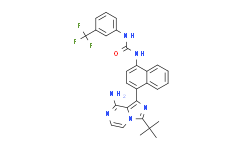| Cas No.: | 1589527-65-0 |
| Chemical Name: | 1-(4-(8-Amino-3-(tert-butyl)imidazo[1,5-a]pyrazin-1-yl)naphthalen-1-yl)-3-(3-(trifluoromethyl)phenyl)urea |
| Synonyms: | KIRA6;1-(4-(8-amino-3-(tert-butyl)imidazo[1,5-a]pyrazin-1-yl)naphthalen-1-yl)-3-(3-(trifluoromethyl)phenyl)urea;1-(4-(8-Amino-3-tert-butylimidazo[1,5-a]pyrazin-1-yl)naphthalen-1-yl)-3-(3-(trifluoromethyl)phenyl)urea;1-[4-(8-amino-3-tert-butylimidazo[1,5-a]pyrazin-1-yl)naphthalen-1-yl]-3-[3-(trifluoromethyl)phenyl]urea;KIRA analog, 2;KIRA 6;BDBM192720;BCP26100;s8658;KIRA 6;KIRA analog, 2;KIRA-6;1-((1E,4Z)-4-(8-amino-3 |
| SMILES: | FC(C1C([H])=C([H])C([H])=C(C=1[H])N([H])C(N([H])C1=C([H])C([H])=C(C2=C([H])C([H])=C([H])C([H])=C21)C1=C2C(N([H])[H])=NC([H])=C([H])N2C(C(C([H])([H])[H])(C([H])([H])[H])C([H])([H])[H])=N1)=O)(F)F |
| Formula: | C28H25F3N6O |
| M.Wt: | 518.5329 |
| Sotrage: | 2 years -20°C Powder, 2 weeks 4°C in DMSO, 6 months -80°C in DMSO |
| Description: | KIRA6 allosterically inhibits IRE1α RNase kinase activity with an IC50 of 0.6 µM. |
| In Vivo: | KIRA6 has negligible toxicity up to 10 μM, providing a favorable therapeutic index to test cytoprotection. KIRA6 in BALB/c mice intraperitoneally (i.p.) dosed at 10 mg/kg shows good drug plasma AUC levels with moderate clearance (22.4 mL/min/kg). Drug half-life is 3.90 hours, Cmax is 3.3 μM, and plasma levels at 4 and 8hr are 1.2 μM and 0.33 μM, respectively. Intravitreal co-injection of KIRA6 with Tm significantly reduces XBP1 splicing, TXNIP induction, and decay of the ER-localized photoreceptor-specific Rhodopsin mRNA. KIRA6 dose-dependently inhibits Rhodopsin RNA cleavage by IRE1α. Concomitant with blockage of Terminal UPR outputs, co-injection of KIRA6 in the Tm model reduces photoreceptor loss by Optical Coherence Tomography (OCT) and histology. KIRA6 substantially protects against loss of ERG responsiveness, significantly preserving both a- and b-wave amplitudes[1]. |
| In Vitro: | KIRA6 dose-dependently inhibits IRE1α (WT) kinase activity, XBP1 RNA cleavage, Ins2 RNA cleavage and oligomerization. KIRA6 strongly inhibits JNK phosphorylation from IRE1α hyperactivation or ER stress. Also, KIRA6 dose-dependently inhibits Ins1 mRNA decay, proinsulin depletion, and apoptosis from IRE1α hyperactivation. In INS-1 cells, KIRA6 inhibits IRE1α auto-phosphorylation by Tg and XBP1 mRNA splicing by Tm in a dose-dependent manner. KIRA6 reduces ER stress-induced death of cultured cells and in pancreatic islet explants[1]. |

 DC Chemicals' products qualify for U.S. tariff exemptions. We guarantee no price increases due to customs duties and maintain stable supply, continuing to deliver reliable research solutions to our American clients.
DC Chemicals' products qualify for U.S. tariff exemptions. We guarantee no price increases due to customs duties and maintain stable supply, continuing to deliver reliable research solutions to our American clients.





















